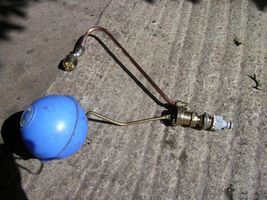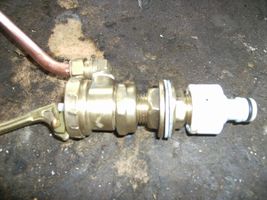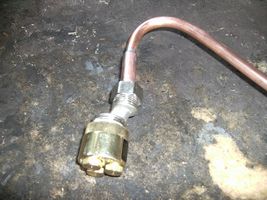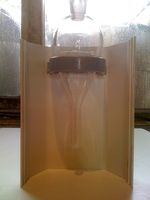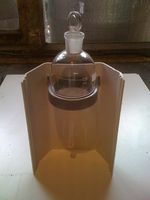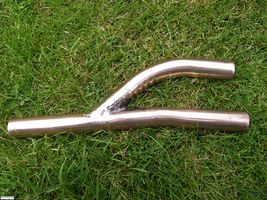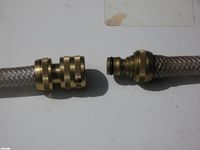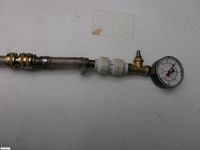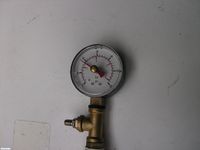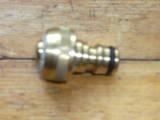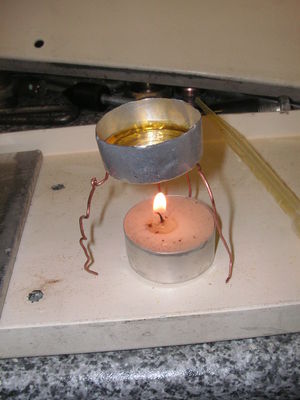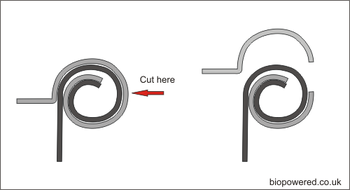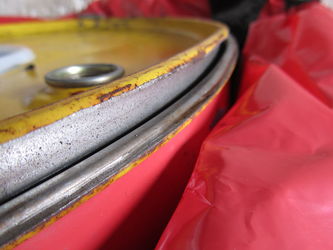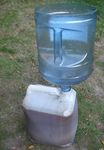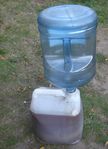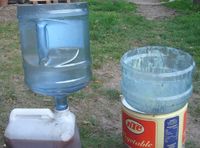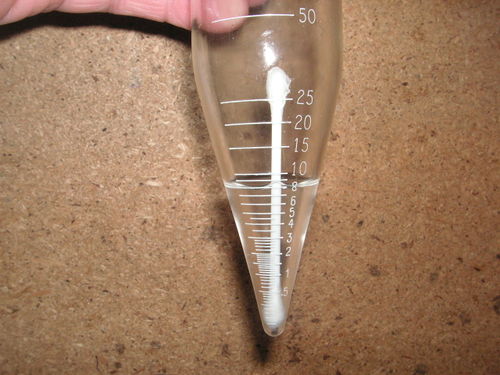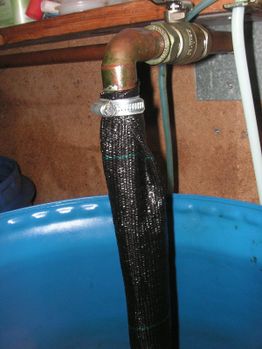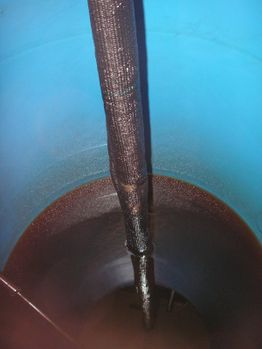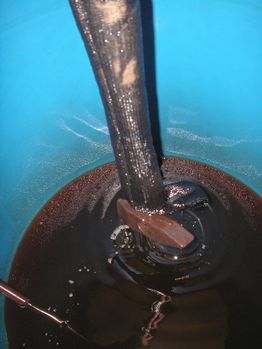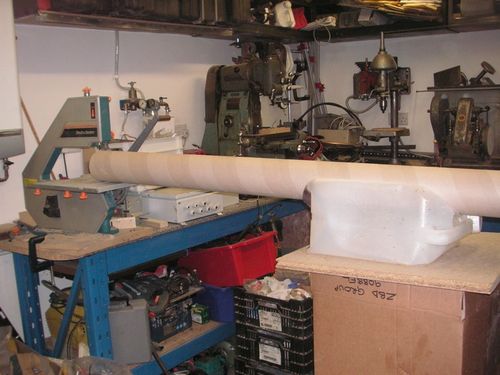Difference between revisions of "Tips and wrinkles 2"
m (→Quick and easy large capacity funnel) |
|||
| (13 intermediate revisions by 3 users not shown) | |||
| Line 1: | Line 1: | ||
| − | To keep the page sizes of biopowered wiki managable, we've started a second | + | To keep the page sizes of biopowered wiki managable, we've started a second tips and wrinkles page ... |
See also [[tips and wrinkles 1]]. | See also [[tips and wrinkles 1]]. | ||
| Line 5: | Line 5: | ||
__TOC__ | __TOC__ | ||
| + | ==Auto shut off misting nozzle== | ||
| + | You need to find a brass ball cock valve then a female hozelock type fitting will fit onto the the inlet (3/4") or use a reducer if it is a 1/2" BSP. | ||
| + | The moveable outlet can be unscrewed and replaced with a 10 mm 90 degree compression fitting, bend a piece of 10 mm copper pipe to achieve the desired height and angle,onto the end of this fit a reducer to take you to the required misting nozzle size, in this case 10 mm to 22 mm. | ||
| + | Work out the desired height on your wash tank and fit, I find this useful as my tank is outside and there is a chance that the tank outlet could freeze in winter. | ||
| + | |||
| + | <gallery caption="click to enlarge" widths="300px" heights="200px" perrow="3" align="center"> | ||
| + | File: Ball_valve_002.jpg |Complete set up. Source: K.H | ||
| + | File: Ball_valve_003.jpg |Tank fitting. Source: K.H | ||
| + | File: Ball_valve_004.jpg |Nozzle Source: K.H | ||
| + | </gallery> | ||
| + | |||
| + | |||
| + | [[User:KH|KH]] 15:30, 28 October 2012 (GMT) | ||
| + | |||
| + | ==Centrifuge vial holder== | ||
| + | An easy to make holder for the vials used in a two stage non titration, it also makes the drop out very visible | ||
| + | You need 8" of gutter and a circular downpipe bracket, attach by cutting two holes in the gutter near the top, pass the two ends of the bracket through the holes and glue in place. | ||
| + | |||
| + | <gallery caption="click to enlarge" widths="300px" heights="200px" perrow="2" align="center"> | ||
| + | File: Vial_holder_2.jpg |Holder. Source: K.H | ||
| + | File: Vial_holder.jpg |Holder. Source: K.H | ||
| + | </gallery> | ||
| + | |||
| + | [[User:KH|KH]] 15:31, 28 October 2012 (GMT) | ||
==Y Piece== | ==Y Piece== | ||
| Line 10: | Line 34: | ||
Just a case of filing/grinding away on the two bits of pipe untill you get a nice close fit and then silver soldering in place | Just a case of filing/grinding away on the two bits of pipe untill you get a nice close fit and then silver soldering in place | ||
| − | <gallery caption="click to enlarge" widths="300px" heights="200px" perrow=" | + | <gallery caption="click to enlarge" widths="300px" heights="200px" perrow="1" align="center"> |
File: Y_Piece_002.jpg|Y piece. Source: K.H | File: Y_Piece_002.jpg|Y piece. Source: K.H | ||
| Line 18: | Line 42: | ||
==Using "Hozelock" type quick release connectors== | ==Using "Hozelock" type quick release connectors== | ||
| − | Not to be used in the | + | Not to be used in the biodiesel making process |
| − | The brass type hozelock connectors can be useful for various connections outside of making | + | The brass type hozelock connectors can be useful for various connections outside of making biodiesel and can be used on small bore( ID 14mm) piping BUT you need to replace the 'O' ring with a "Viton" type. |
| − | The O ring is 2mm with a diameter of 12mm,the plastic that clamps the pipe to the fitting is ok with biodiesel but they can be done away with and a jubilee clip used anyway,they also remain airtight upto about 20 PSI (see pics) | + | |
| + | The 'O' ring is 2mm with a diameter of 12mm,the plastic that clamps the pipe to the fitting is ok with biodiesel but they can be done away with and a jubilee clip used anyway,they also remain airtight upto about 20 PSI (see pics) | ||
| Line 39: | Line 64: | ||
1 night light, the container from a second and a piece of bent electrical wire. It reaches temperature very quickly, but due to the flimsy nature of the container, cools down when the oil is added. So it needs to be left with the flame burning for a few minutes to reheat. | 1 night light, the container from a second and a piece of bent electrical wire. It reaches temperature very quickly, but due to the flimsy nature of the container, cools down when the oil is added. So it needs to be left with the flame burning for a few minutes to reheat. | ||
| − | <gallery caption="Micro HPT" widths="350px" heights="400px" perrow=" | + | <gallery caption="Micro HPT" widths="350px" heights="400px" perrow="1" align="center"> |
File: Micro HPT.JPG | File: Micro HPT.JPG | ||
</gallery> | </gallery> | ||
| Line 67: | Line 92: | ||
| − | <gallery caption="click to enlarge" widths=" | + | <gallery caption="click to enlarge" widths="200px" heights="150px" perrow="3" align="center"> |
| − | File:20ltr funnel 1.jpg| 20ltr Funnel | + | File:20ltr funnel 1.jpg| 20ltr Funnel |
| − | File:20ltr funnel & lid.jpg| 20ltr Funnel with lid | + | File:20ltr funnel & lid.jpg| 20ltr Funnel with lid |
| − | File:20ltr funnel & 10ltr funnel.jpg| 20ltr Funnel & 10ltr Funnel | + | File:20ltr funnel & 10ltr funnel.jpg| 20ltr Funnel & 10ltr Funnel |
| + | </gallery> | ||
| + | [[User:max.print|max.print]] 23:45, 03 October 2011 (BST) | ||
| + | |||
| + | |||
| + | ==Cleaning a 3/27 conical flask== | ||
| + | |||
| + | A quick and easy way to clean a 3/27 conical flask is to add some [[Isopropyl alcohol|IPA]], acetone or similar, drop in a cotton bud and shake vigourously. No risk of damage to the tube. | ||
| + | |||
| + | [[File:3-27 tube clean.JPG|500px]] | ||
| + | |||
| + | [[User:Julian|Julian]] ([[User talk:Julian|talk]]) 08:19, 26 October 2013 (PDT) | ||
| + | |||
| + | |||
| + | |||
| + | ==Mini sock filter to prevent sediment agitation== | ||
| + | |||
| + | When pumping from the processor to a settling tank, simply dropping the biodiesel in from a height can stir up sediment and soap that’s already settled. To prevent this a small diameter sock filter can be sewn from landscaping fabric. | ||
| + | |||
| + | The aim is not so much to filter the biodiesel, as the fabric is a very course weave, but to allow the incoming biodiesel to be added gently to the tank. It was found that the bio was aerated using a peripheral pump, so a weight can be fixed to the end to prevent the sock from floating to the surface. Best results are obtained if the sock extends into the bio which remains at the bottom of the tank. | ||
| + | |||
| + | <gallery caption="Mini sick filter to prevent sediment agitation widths="280px" heights="350px" perrow="3" align="center"> | ||
| + | File:Mini_sock_1.jpg | The sock is attached to the inlet pipe with a hose clip. | ||
| + | File:Mini_sock_2.jpg | The sock should extend into the “dead” volume at the bottom of the tank. | ||
| + | File:Mini_sock_3.JPG | It’s advantageous to weight the sock down … an old hammer head fixed with copper wire in this case. | ||
</gallery> | </gallery> | ||
| − | [[User: | + | |
| + | [[User:Julian|Julian]]([[User talk:Julian|talk]]) 08:19, 26 October 2013 (PDT) | ||
| + | |||
| + | |||
| + | |||
| + | |||
| + | ==Empty cubie helps cutting carpet cores for glogs== | ||
| + | |||
| + | The writer uses a band saw to cut carpet cores to 8" lengths for glogs. In long lengths, these can be a little unwieldy when trying to balance them on a small saw table. | ||
| + | |||
| + | A suitable stack of boxes etc topped with an empty cubie solves the problem. The cubie lid is loosened and the core pushed into the cubie to form a guide. The lid can then be tightened to retain the shape and height. The core is now supported at the right height, won't roll off the table and is easily slid and rotated on the cubie. | ||
| + | |||
| + | The idea needn't be limited to carpet cores, the idea should work for many other items and profiles being worked on various machines. | ||
| + | |||
| + | [[File:Cubie rest.jpg|500px]] | ||
| + | |||
| + | [[User:Julian|Julian]] ([[User talk:Julian|talk]]) 11:48, 6 April 2014 (PDT) | ||
| + | |||
| + | |||
See also [[tips and wrinkles 1]]. | See also [[tips and wrinkles 1]]. | ||
Latest revision as of 18:48, 6 April 2014
To keep the page sizes of biopowered wiki managable, we've started a second tips and wrinkles page ...
See also tips and wrinkles 1.
Contents
- 1 Auto shut off misting nozzle
- 2 Centrifuge vial holder
- 3 Y Piece
- 4 Using "Hozelock" type quick release connectors
- 5 Micro HPT
- 6 Drum lid removal
- 7 Quick and easy large capacity funnel
- 8 Cleaning a 3/27 conical flask
- 9 Mini sock filter to prevent sediment agitation
- 10 Empty cubie helps cutting carpet cores for glogs
Auto shut off misting nozzle
You need to find a brass ball cock valve then a female hozelock type fitting will fit onto the the inlet (3/4") or use a reducer if it is a 1/2" BSP. The moveable outlet can be unscrewed and replaced with a 10 mm 90 degree compression fitting, bend a piece of 10 mm copper pipe to achieve the desired height and angle,onto the end of this fit a reducer to take you to the required misting nozzle size, in this case 10 mm to 22 mm. Work out the desired height on your wash tank and fit, I find this useful as my tank is outside and there is a chance that the tank outlet could freeze in winter.
- click to enlarge
KH 15:30, 28 October 2012 (GMT)
Centrifuge vial holder
An easy to make holder for the vials used in a two stage non titration, it also makes the drop out very visible You need 8" of gutter and a circular downpipe bracket, attach by cutting two holes in the gutter near the top, pass the two ends of the bracket through the holes and glue in place.
- click to enlarge
KH 15:31, 28 October 2012 (GMT)
Y Piece
Useful for separating off the flow when using an Eductor Just a case of filing/grinding away on the two bits of pipe untill you get a nice close fit and then silver soldering in place
- click to enlarge
KH 22:47, 25 June 2011 (BST)
Using "Hozelock" type quick release connectors
Not to be used in the biodiesel making process
The brass type hozelock connectors can be useful for various connections outside of making biodiesel and can be used on small bore( ID 14mm) piping BUT you need to replace the 'O' ring with a "Viton" type.
The 'O' ring is 2mm with a diameter of 12mm,the plastic that clamps the pipe to the fitting is ok with biodiesel but they can be done away with and a jubilee clip used anyway,they also remain airtight upto about 20 PSI (see pics)
- click to enlarge
KH 23:45, 25 June 2011 (BST)
Micro HPT
Quick, simple and cheap method for performing the HPT which means you don't have to use the kitchen stove with associated smell in the house!
1 night light, the container from a second and a piece of bent electrical wire. It reaches temperature very quickly, but due to the flimsy nature of the container, cools down when the oil is added. So it needs to be left with the flame burning for a few minutes to reheat.
- Micro HPT
Bio-rich-time-poor 12:10, 26 June 2011 (BST)
Drum lid removal
A novel idea from littledave. Slice through a drum seam with a 1mm cutting disk on an angle grinder and you have a removable lid. Dave recommends marking the lid and drum so the lid can be replaced in the same position each time. Not all drums will be perfectly circular and the position of the cut may not be in the same place around the circumference.
- Drum seam cutting
Bio-rich-time-poor 23:15, 27 June 2011 (BST)
Quick and easy large capacity funnel
You can make a large capacity funnel by cutting the bottom off of an old water dispenser bottle. They are such a good interferance fit in a standard 20ltr cubie that they are self supporting.
If you want a lid for your new funnel, first cut the lid from the bottom of the bottle cutting at the fattest part of a ribbed section and then cut the funnel from the remains cutting on the thinnest part of a ribbed section.
If you cut the bottle roughly in half, you get a more stable, but lower capacity, funnel ideal for use with 20ltr tins that have a slightly larger hole.
Remember to take care when you begin to fill an empty cubie as it is easy to make it top heavy and it can fall over.
- click to enlarge
max.print 23:45, 03 October 2011 (BST)
Cleaning a 3/27 conical flask
A quick and easy way to clean a 3/27 conical flask is to add some IPA, acetone or similar, drop in a cotton bud and shake vigourously. No risk of damage to the tube.
Julian (talk) 08:19, 26 October 2013 (PDT)
Mini sock filter to prevent sediment agitation
When pumping from the processor to a settling tank, simply dropping the biodiesel in from a height can stir up sediment and soap that’s already settled. To prevent this a small diameter sock filter can be sewn from landscaping fabric.
The aim is not so much to filter the biodiesel, as the fabric is a very course weave, but to allow the incoming biodiesel to be added gently to the tank. It was found that the bio was aerated using a peripheral pump, so a weight can be fixed to the end to prevent the sock from floating to the surface. Best results are obtained if the sock extends into the bio which remains at the bottom of the tank.
- "Mini
Julian(talk) 08:19, 26 October 2013 (PDT)
Empty cubie helps cutting carpet cores for glogs
The writer uses a band saw to cut carpet cores to 8" lengths for glogs. In long lengths, these can be a little unwieldy when trying to balance them on a small saw table.
A suitable stack of boxes etc topped with an empty cubie solves the problem. The cubie lid is loosened and the core pushed into the cubie to form a guide. The lid can then be tightened to retain the shape and height. The core is now supported at the right height, won't roll off the table and is easily slid and rotated on the cubie.
The idea needn't be limited to carpet cores, the idea should work for many other items and profiles being worked on various machines.
Julian (talk) 11:48, 6 April 2014 (PDT)
See also tips and wrinkles 1.
